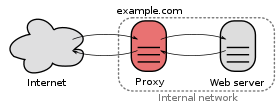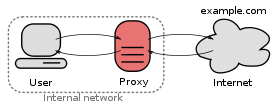The proxy concept was invented in the early days of distributed systems as a way to simplify and control their complexity. Today, most proxies are web proxies, facilitating access to content on the World Wide Web.
Uses
A proxy server has a large variety of potential purposes, including:
- To keep machines behind it anonymous, mainly for security.
- To speed up access to resources (using caching). Web proxies are commonly used to cache web pages from a web server.
- To apply access policy to network services or content, e.g. to block undesired sites.
- To access sites prohibited or filtered by your ISP or institution.
- To log / audit usage, i.e. to provide company employee Internet usage reporting.
- To bypass security / parental controls.
- To circumvent Internet filtering to access content otherwise blocked by governments.
- To scan transmitted content for malware before delivery.
- To scan outbound content, e.g., for data loss prevention.
- To allow a web site to make web requests to externally hosted resources (e.g. images, music files, etc.) when cross-domain restrictions prohibit the web site from linking directly to the outside domains.
A proxy server that passes requests and responses unmodified is usually called a gateway or sometimes tunneling proxy.
A proxy server can be placed in the user's local computer or at various points between the user and the destination servers on the Internet.
A reverse proxy is (usually) an Internet-facing proxy used as a front-end to control and protect access to a server on a private network, commonly also performing tasks such as load-balancing, authentication, decryption or caching.
Proxy Tipe:
Forward proxies are proxies where the client server names the target server to connect to. Forward proxies are able to retrieve from a wide range of sources (in most cases anywhere on the Internet).
The terms "forward proxy" and "forwarding proxy" are a general description of behaviour (forwarding traffic) and thus ambiguous. Except for Reverse proxy, the types of proxies described on this article are more specialized sub-types of the general forward proxy concept. Reverse proxies are installed in the neighborhood of one or more web servers. All traffic coming from the Internet and with a destination of one of the neighborhood's web servers goes through the proxy server. The use of "reverse" originates in its counterpart "forward proxy" since the reverse proxy sits closer to the web server and serves only a restricted set of websites.
Reverse proxies are installed in the neighborhood of one or more web servers. All traffic coming from the Internet and with a destination of one of the neighborhood's web servers goes through the proxy server. The use of "reverse" originates in its counterpart "forward proxy" since the reverse proxy sits closer to the web server and serves only a restricted set of websites.
Uses of proxy servers
The terms "forward proxy" and "forwarding proxy" are a general description of behaviour (forwarding traffic) and thus ambiguous. Except for Reverse proxy, the types of proxies described on this article are more specialized sub-types of the general forward proxy concept.
Open proxies
An open proxy is a forward proxy server that is accessible by any Internet user. Gordon Lyon estimates there are "hundreds of thousands" of open proxies on the Internet. An anonymous open proxy allows users to conceal their IP address while browsing the Web or using other Internet services.
Reverse proxies
A reverse proxy (or surrogate) is a proxy server that
appears to clients to be an ordinary server. Requests are forwarded to one or more origin servers which handle the request. The response is returned as if it came directly from the proxy server.
 Reverse proxies are installed in the neighborhood of one or more web servers. All traffic coming from the Internet and with a destination of one of the neighborhood's web servers goes through the proxy server. The use of "reverse" originates in its counterpart "forward proxy" since the reverse proxy sits closer to the web server and serves only a restricted set of websites.
Reverse proxies are installed in the neighborhood of one or more web servers. All traffic coming from the Internet and with a destination of one of the neighborhood's web servers goes through the proxy server. The use of "reverse" originates in its counterpart "forward proxy" since the reverse proxy sits closer to the web server and serves only a restricted set of websites.There are several reasons for installing reverse proxy servers:
- Encryption / SSL acceleration: when secure web sites are created, the SSL encryption is often not done by the web server itself, but by a reverse proxy that is equipped with SSL acceleration hardware. See Secure Sockets Layer. Furthermore, a host can provide a single "SSL proxy" to provide SSL encryption for an arbitrary number of hosts; removing the need for a separate SSL Server Certificate for each host, with the downside that all hosts behind the SSL proxy have to share a common DNS name or IP address for SSL connections. This problem can partly be overcome by using the SubjectAltName feature of X.509 certificates.
- Load balancing: the reverse proxy can distribute the load to several web servers, each web server serving its own application area. In such a case, the reverse proxy may need to rewrite the URLs in each web page (translation from externally known URLs to the internal locations).
- Serve/cache static content: A reverse proxy can offload the web servers by caching static content like pictures and other static graphical content.
- Compression: the proxy server can optimize and compress the content to speed up the load time.
- Spoon feeding: reduces resource usage caused by slow clients on the web servers by caching the content the web server sent and slowly "spoon feeding" it to the client. This especially benefits dynamically generated pages.
- Security: the proxy server is an additional layer of defense and can protect against some OS and WebServer specific attacks. However, it does not provide any protection to attacks against the web application or service itself, which is generally considered the larger threat.
- Extranet Publishing: a reverse proxy server facing the Internet can be used to communicate to a firewalled server internal to an organization, providing extranet access to some functions while keeping the servers behind the firewalls. If used in this way, security measures should be considered to protect the rest of your infrastructure in case this server is compromised, as its web application is exposed to attack from the Internet.
Uses of proxy servers
Filtering A content-filtering web proxy server provides administrative control over the content that may be relayed through the proxy. It is commonly used in both commercial and non-commercial organizations (especially schools) to ensure that Internet usage conforms to acceptable use policy. In some cases users can circumvent the proxy, since there are services designed to proxy information from a filtered website through a non filtered site to allow it through the user's proxy.
A content filtering proxy will often support user authentication, to control web access. It also usually produces logs, either to give detailed information about the URLs accessed by specific users, or to monitor bandwidth usage statistics. It may also communicate to daemon-based and/or ICAP-based antivirus software to provide security against virus and other malware by scanning incoming content in real time before it enters the network.
Many work places, schools, and colleges restrict the web sites and online services that are made available in their buildings. This is done either with a specialized proxy, called a content filter (both commercial and free products are available), or by using a cache-extension protocol such as ICAP, that allows plug-in extensions to an open caching architecture.
Some common methods used for content filtering include: URL or DNS blacklists, URL regex filtering, MIME filtering, or content keyword filtering. Some products have been known to employ content analysis techniques to look for traits commonly used by certain types of content providers.
Requests made to the open internet must first pass through an outbound proxy filter. The web-filtering company provides a database of URL patterns (regular expressions) with associated content attributes. This database is updated weekly by site-wide subscription, much like a virus filter subscription. The administrator instructs the web filter to ban broad classes of content (such as sports, pornography, online shopping, gambling, or social networking). Requests that match a banned URL pattern are rejected immediately.
Assuming the requested URL is acceptable, the content is then fetched by the proxy. At this point a dynamic filter may be applied on the return path. For example, JPEG files could be blocked based on fleshtone matches, or language filters could dynamically detect unwanted language. If the content is rejected then an HTTP fetch error is returned and nothing is cached.
Extranet Publishing: a reverse proxy server facing the Internet can be used to communicate to a firewalled server internal to an organization, providing extranet access to some functions while keeping the servers behind the firewalls. If used in this way, security measures should be considered to protect the rest of your infrastructure in case this server is compromised, as its web application is exposed to attack from the Internet
Most web filtering companies use an internet-wide crawling robot that assesses the likelihood that a content is a certain type. The resultant database is then corrected by manual labor based on complaints or known flaws in the content-matching algorithms.
Web filtering proxies are not able to peer inside secure sockets HTTP transactions, assuming the chain-of-trust of SSL/TLS has not been tampered with. As a result, users wanting to bypass web filtering will typically search the internet for an open and anonymous HTTPS transparent proxy. They will then program their browser to proxy all requests through the web filter to this anonymous proxy. Those requests will be encrypted with https. The web filter cannot distinguish these transactions from, say, a legitimate access to a financial website. Thus, content filters are only effective against unsophisticated users.
As mentioned above, the SSL/TLS chain-of-trust does rely on trusted root certificate authorities; in a workplace setting where the client is managed by the organization, trust might be granted to a root certificate whose private key is known to the proxy. Concretely, a root certificate generated by the proxy is installed into the browser CA list by IT staff. In such scenarios, proxy analysis of the contents of a SSL/TLS transaction becomes possible. The proxy is effectively operating a man-in-the-middle attack, allowed by the client's trust of a root certificate the proxy owns.
A special case of web proxies is "CGI proxies". These are web sites that allow a user to access a site through them. They generally use PHP or CGI to implement the proxy functionality. These types of proxies are frequently used to gain access to web sites blocked by corporate or school proxies. Since they also hide the user's own IP address from the web sites they access through the proxy, they are sometimes also used to gain a degree of anonymity, called "Proxy Avoidance".
Caching
A caching proxy server accelerates service requests by retrieving content saved from a previous request made by the same client or even other clients. Caching proxies keep local copies of frequently requested resources, allowing large organizations to significantly reduce their upstream bandwidth usage and costs, while significantly increasing performance. Most ISPs and large businesses have a caching proxy. Caching proxies were the first kind of proxy server.
Some poorly-implemented caching proxies have had downsides (e.g., an inability to use user authentication). Some problems are described in RFC 3143 (Known HTTP Proxy/Caching Problems).
Another important use of the proxy server is to reduce the hardware cost. An organization may have many systems on the same network or under control of a single server, prohibiting the possibility of an individual connection to the Internet for each system. In such a case, the individual systems can be connected to one proxy server, and the proxy server connected to the main server. An example of a software caching proxy is Squid.
DNS proxy
A DNS proxy server takes DNS queries from a (usually local) network and forwards them to an Internet Domain Name Server. It may also cache DNS records.
Bypassing filters and censorship
If the destination server filters content based on the origin of the request, the use of a proxy can circumvent this filter. For example, a server using IP-based geolocation to restrict its service to a certain country can be accessed using a proxy located in that country to access the service.
Likewise, a badly configured proxy can provide access to a network otherwise isolated from the Internet.
Logging and eavesdropping
Proxies can be installed in order to eavesdrop upon the data-flow between client machines and the web. All content sent or accessed – including passwords submitted and cookies used – can be captured and analyzed by the proxy operator. For this reason, passwords to online services (such as webmail and banking) should always be exchanged over a cryptographically secured connection, such as SSL.
By chaining proxies which do not reveal data about the original requester, it is possible to obfuscate activities from the eyes of the user's destination. However, more traces will be left on the intermediate hops, which could be used or offered up to trace the user's activities. If the policies and administrators of these other proxies are unknown, the user may fall victim to a false sense of security just because those details are out of sight and mind.
In what is more of an inconvenience than a risk, proxy users may find themselves being blocked from certain Web sites, as numerous forums and Web sites block IP addresses from proxies known to have spammed or trolled the site. Proxy bouncing can be used to maintain your privacy.
Gateways to private networks
Proxy servers can perform a role similar to a network switch in linking two networks.
Accessing services anonymously
An anonymous proxy server (sometimes called a web proxy) generally attempts to anonymize web surfing. There are different varieties of anonymizers. The destination server (the server that ultimately satisfies the web request) receives requests from the anonymizing proxy server, and thus does not receive information about the end user's address. However, the requests are not anonymous to the anonymizing proxy server, and so a degree of trust is present between the proxy server and the user. Many of them are funded through a continued advertising link to the user.
Access control: Some proxy servers implement a logon requirement. In large organizations, authorized users must log on to gain access to the web. The organization can thereby track usage to individuals.
Some anonymizing proxy servers may forward data packets with header lines such as HTTP_VIA, HTTP_X_FORWARDED_FOR, or HTTP_FORWARDED, which may reveal the IP address of the client. Other anonymizing proxy servers, known as elite or high anonymity proxies, only include the REMOTE_ADDR header with the IP address of the proxy server, making it appear that the proxy server is the client. A website could still suspect a proxy is being used if the client sends packets which include a cookie from a previous visit that did not use the high anonymity proxy server. Clearing cookies, and possibly the cache, would solve this problem.


 00.43
00.43
 Hendri Dwi Atmaja
Hendri Dwi Atmaja



0 komentar:
Posting Komentar